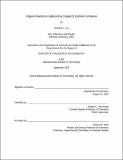| dc.contributor.advisor | Stephen L. Buchwald. | en_US |
| dc.contributor.author | Liu, Richard Y.(Richard Yifan) | en_US |
| dc.contributor.other | Massachusetts Institute of Technology. Department of Chemistry. | en_US |
| dc.date.accessioned | 2020-03-09T18:58:26Z | |
| dc.date.available | 2020-03-09T18:58:26Z | |
| dc.date.copyright | 2019 | en_US |
| dc.date.issued | 2019 | en_US |
| dc.identifier.uri | https://hdl.handle.net/1721.1/124110 | |
| dc.description | This electronic version was submitted by the student author. The certified thesis is available in the Institute Archives and Special Collections. | en_US |
| dc.description | Thesis: Ph. D., Massachusetts Institute of Technology, Department of Chemistry, 2019 | en_US |
| dc.description | Cataloged from student-submitted PDF version of thesis. | en_US |
| dc.description | Includes bibliographical references. | en_US |
| dc.description.abstract | Chapter 2. Regiodivergent and Diastereoselective CuH-Catalyzed Allylation of Imines with Terminal Allenes A chemoselective hydrometalation process enables the use of easily accessible allenes as allylmetal nucleophile surrogates in imine allylation reactions. By modulating the nitrogen-protecting group, either highly branched- or linear-selective addition can be achieved from the same allene. Both reactions exhibit excellent diastereoselectivity and broad functional-group tolerance. Good enantioselectivity can also be achieved in the linear-selective reaction. Finally, a mechanistic model for the regiodivergence is proposed on the basis of density functional theory calculations. Chapter 3. Enantioselective Ketone Allylation Using Allene, a Petroleum Cracking Byproduct Allene gas is produced and separated on million-metric-ton scale per year during petroleum refining but is rarely employed in organic synthesis. | en_US |
| dc.description.abstract | Meanwhile, the addition of an allyl group to ketones is among the most common and prototypical reactions in synthetic chemistry. It is shown that the combination of allene gas with inexpensive and environmentally benign hydrosilanes can serve as a replacement for the allylmetal reagents that are required in most enantioselective ketone allylation reactions. This process is catalyzed by copper salts and commercially available ligands, operates without specialized equipment or pressurization, and tolerates a broad range of functional groups. Furthermore, the exceptional chemoselectivity of this catalyst system enables industrially relevant C3 hydrocarbon mixtures of allene with methylacetylene and propylene to be applied directly. Chapter 4. CuH-Catalyzed Enantioselective Ketone Allylation with 1,3-Dienes An efficient method for the copper-catalyzed allylation of ketones is described using widely available 1,3-dienes as allylmetal surrogates. | en_US |
| dc.description.abstract | Homoallylic alcohols bearing a wide range of functional groups are obtained in high yield and with good regio-, diastereo-, and enantioselectivity. Mechanistic investigations using density functional theory implicate the in situ formation of a rapidly equilibrating mixture of isomeric copper(I) allyl complexes, from which Curtin-Hammett kinetics determine the major isomer of the product. A stereochemical model is provided to explain the high diastereo- and enantioselectivity of this process. Chapter 5. A Mild CuH-Catalyzed Dehydration of Primary Amides to Nitriles Metal-catalyzed silylative dehydration of primary amides is an economical approach to the synthesis of nitriles. This Chapter describes a copper(I) hydride (CuH)-catalyzed dehydration process that avoids a typically challenging 1,2-siloxane elimination step, thereby dramatically increasing the rate of the overall transformation relative to alternative metal-catalyzed systems. | en_US |
| dc.description.abstract | This new reaction proceeds at ambient temperature, tolerates a variety of metal-, acid-, or base-sensitive functional groups, and can be performed using a simple ligand, inexpensive siloxanes, and low catalyst loading. Chapter 6. Attractive Ligand-Substrate Dispersion Interactions in the Copper-Catalyzed Hydroamination of Unactivated Olefins London dispersion interactions between the ligand and the substrate, although ubiquitous, are seldom accounted for in mechanistic models of transition-metal-catalyzed transformations. Computational models shown that in the copper(I) hydride (CuH)-catalyzed hydroamination of unactivated olefins, the substantially enhanced reactivity of copper catalysts based on bulky bidentate phosphine ligands originates from attractive ligand-substrate dispersion interactions. | en_US |
| dc.description.abstract | This Chapter describes kinetic studies across a range of hydroamination reactions using structurally diverse phosphine ligands that, in conjunction with the theoretical results, reveal the critical role of bulky P-aryl groups in facilitating this process. | en_US |
| dc.description.statementofresponsibility | by Richard Y. Liu. | en_US |
| dc.format.extent | 588 pages | en_US |
| dc.language.iso | eng | en_US |
| dc.publisher | Massachusetts Institute of Technology | en_US |
| dc.rights | MIT theses are protected by copyright. They may be viewed, downloaded, or printed from this source but further reproduction or distribution in any format is prohibited without written permission. | en_US |
| dc.rights.uri | http://dspace.mit.edu/handle/1721.1/7582 | en_US |
| dc.subject | Chemistry. | en_US |
| dc.title | Organic reactions catalyzed by copper(I) hydride complexes | en_US |
| dc.type | Thesis | en_US |
| dc.description.degree | Ph. D. | en_US |
| dc.contributor.department | Massachusetts Institute of Technology. Department of Chemistry | en_US |
| dc.identifier.oclc | 1142098944 | en_US |
| dc.description.collection | Ph.D. Massachusetts Institute of Technology, Department of Chemistry | en_US |
| dspace.imported | 2020-03-09T18:58:25Z | en_US |
| mit.thesis.degree | Doctoral | en_US |
| mit.thesis.department | Chem | en_US |
